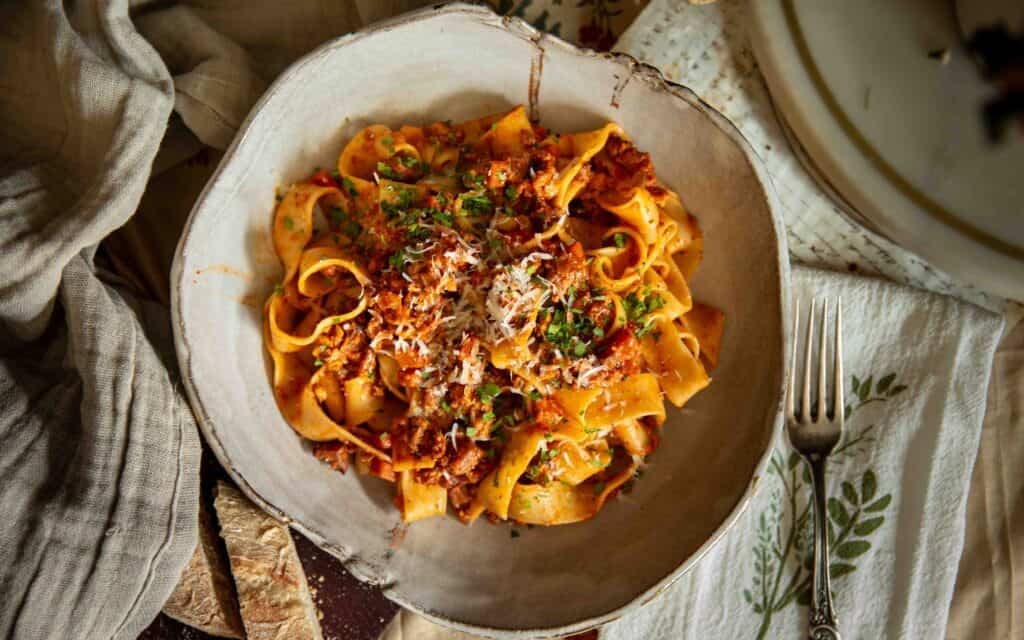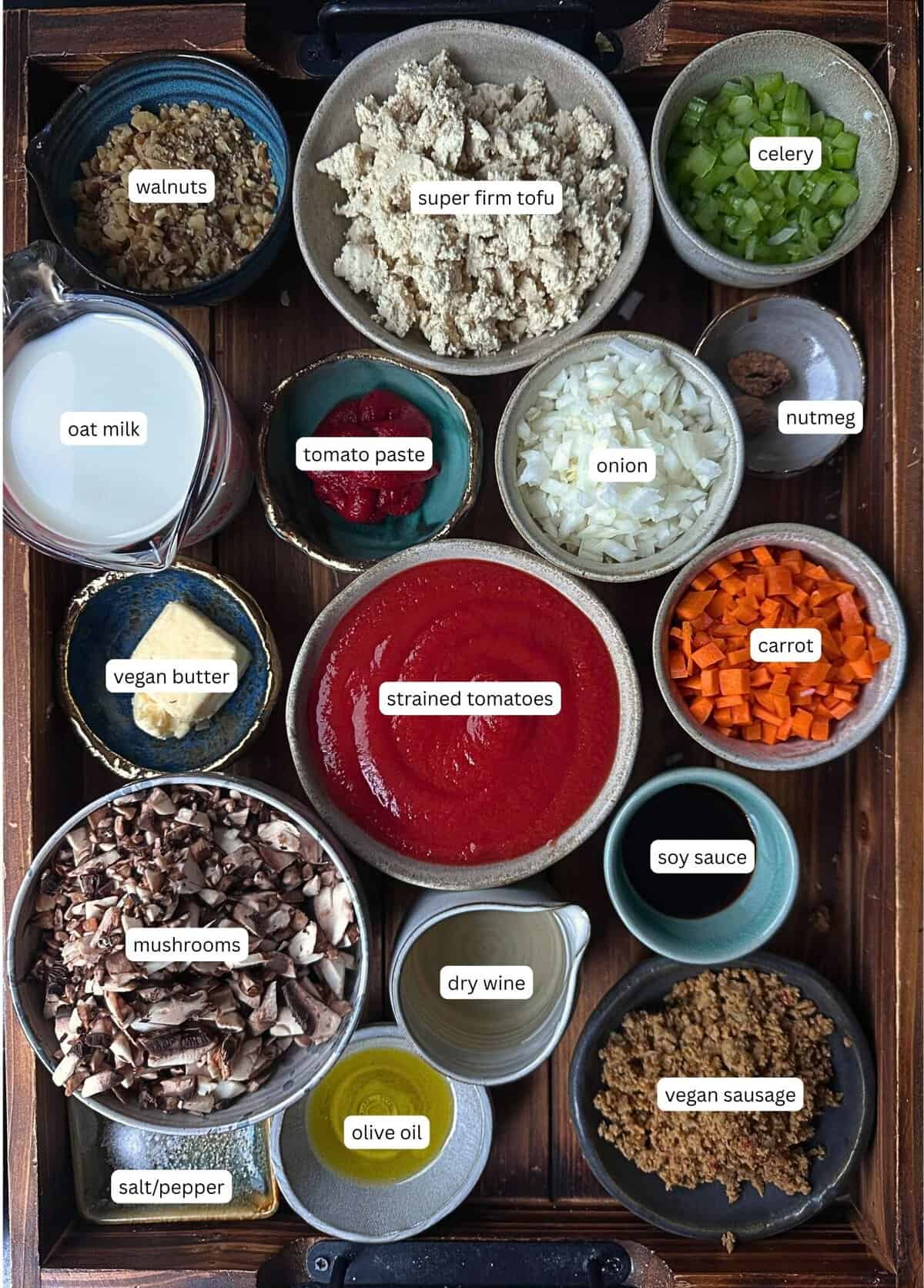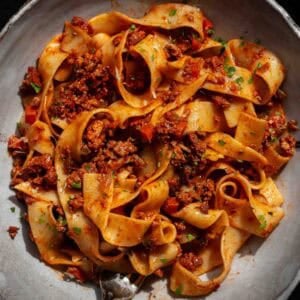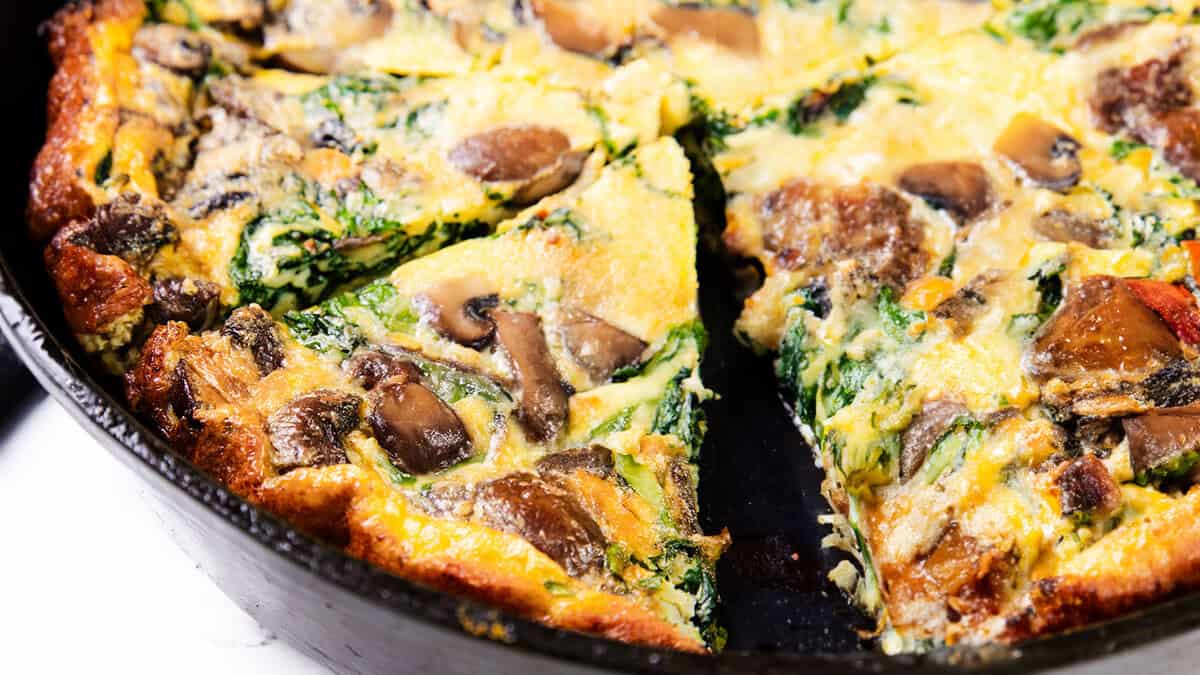Delicious.
Protein-packed.
HEALTHY.
This vegan bolognese recipe is going to knock your socks off. I mean it! I spent hours and hours combing through recipes for a traditional bolognese sauce so that I could develop a recipe for vegan bolognese sauce that comes as close as possible to the original and I genuinely believe that this is the best vegan bolognese ever! I even consulted the official recipe for traditional bolognese from Bologna, Italy!! Yes, of course, I had to make some changes for this plant-based twist on this classic Italian ragù, but don’t be surprised if none of your meat-loving friends can tell the difference!
So, without further ado, let’s get into it!
Disclaimer: Some of the links in this post may be affiliate links for products I use and love. If you make a purchase after clicking one of those links, I may earn a small affiliate commission, perhaps enough to buy some extra gochujang or gochugaru 🙂
What is Bolognese?
The hallmark of a bolognese is the meaty texture and the rich flavor. It’s a hearty sauce that really sticks to your pasta (and your bones)! Before we get to talking about how we develop a plant-based take (that is probably less taxing on your body, to be honest!) on this meat sauce, we first need to discuss what the original looks like.
The word “bolognese” in Italian literally means “from Bologna,” in reference to the city situated in northern Italy. The term “bolognese,” for many Americans or other English-speaking people, is shorthand for the phrase “ragù alla bolognese,” which means “meat sauce in the style of Bologna.” The undisputed star of the traditional bolognese pasta sauce recipe is meat: either ground beef or some kind of pork. In fact, the sauce often simmers in a beef or pork broth.
In addition to ground meat, the components of bolognese are pretty straightforward: onion, carrot, celery (this trio is often referred to as “soffritto”), tomato paste or sauce, a dry wine (red or white), and dairy (milk, cream, butter). Like so many Italian classics, bolognese is made out of simple ingredients, relying heavily on what’s locally available. In Bologna, as is the case with much of northern Italy, olive trees are not as prevalent (because of the cooler climates), and therefore, butter and dairy is as often the fat source as olive oil. As you can see, this is not a vegan friendly recipe, but I was still quite determined to do a job of it!
What’s not in a Traditional Bolognese?

A couple interesting things I noted in my research is that the traditional bolognese does not include:
- garlic
- fresh herbs
- dried herbs
- fresh tomatoes
I know, some of these left me scratching my head, but again, it sort of tracks, right? The bolognese is supposed to be a meat sauce and I guess the nonnas didn’t want anything strong like fresh garlic or herbs hindering the meat from really being the star. Fresh tomatoes, as we’ll talk about later, impart too much liquid, which, again, undermines the meaty texture.
How is bolognese typically served? In Italy, this meaty sauce is served with a wide, flat pasta called tagliatelle. Despite what you may have seen on blogs, social media, or even on menus here in the States, bolognese is generally not served with spaghetti noodles. We’ll talk more about some of the “rules” of bolognese as we discuss the key ingredients and substitutions below!
Why You’ll Love this vegan bolognese Recipe.
You’re going to love this vegan bolognese sauce recipe because it’s:
- easy
- healthy
- hi-protein
- delicious
This easy recipe for vegan bolognese comes with great flavor and a texture that perfectly mimics an authentic meat sauce. It also includes multiple opportunities to make it as rich as you want for your dinner parties or to dial back some of the fat in order to keep it lighter for your perfect weeknight meal (check out the oil-free substitution tips!). Whether this is your first time making a bolognese or you’ve been making vegan meat sauces every week, this vegan bolognese recipe is going to be your go-to recipe because it’s perfect for the whole family–whether or not they are meatless themselves.
Key Ingredients and Notes on Substitutions for Vegan Bolognese Recipe.
In order to come up with a respectable vegan bolognese (or vegetarian bolognese recipe), I had to make a few significant adjustments. Let’s discuss and the reasoning for them in turn:
Super Firm Tofu.
The main source of our plant-based protein for this vegan bolognese will be tofu. I know that many popular vegan bolognese recipes use red lentils, green lentils, brown lentils, or some combination of all of them. But, I’m a bigger fan of super firm tofu. Pound for pound, it packs more protein than lentils (though, to be fair, lentils do win out in the fiber-fight!). Plus, I think tofu (the way we’ll prepare them here) does a much better job of creating the texture of a traditional bolognese. Finally, tofu has little of its own flavor and, instead, sucks up the flavor of everything around it.
Substitution Tip: I use super firm tofu for this vegan bolognese recipe because it has so much of the liquid expressed out of it (which is what will help create the spongy, meaty texture for this sauce). If you don’t have access to super firm tofu, you can use extra-firm tofu that has been pressed for at least 20 minutes.
Soy Sauce.
Though this vegan bolognese uses tofu, tofu, by itself, has almost no flavor. Tofu also has very little fat, compared to ground meat. If you’re watching your fat intake, that’s a good thing (we’ll talk more about this later). But, lack of fat also means not a lot of flavor. Thus, in order to amp up the umami flavor for this vegan bolognese, the tofu gets treated with just a little bit of soy sauce.
Substitution Tips: If you want to keep this recipe gluten-free, make sure to use gluten-free soy sauce or tamari sauce. And of course, if you want to cut down on your sodium, you can use a low-sodium soy sauce. If you want to keep this soy free, you can use soy-free “soy” sauce or coconut aminos.
Vegan Italian Sausage.
In addition to the super firm tofu, this vegan bolognese incorporates a vegan Italian sausage to, again, provide some extra flavor and extra richness. I use Field Roast’s Italian sausages, but feel free to use whatever vegan sausage you have access to.
Substitution Tips: If you don’t have a good vegan Italian sausage option (or you don’t want to use one), you can substitute with more super-firm tofu or mushrooms (see below), plus a tablespoon of fennel seeds.
Mushrooms.
While traditional bolognese does not include mushrooms, this vegan bolognese does. Why? Because the right mushroom can really help add that earthy flavor and hearty texture that does such a great job of mimicking meat. Here, I used baby bella mushrooms, but you can use shiitake, full portobello mushrooms, or even maitake mushrooms.
Walnuts.

Ok, for sure, none of the Italian chefs were adding walnuts to their traditional bolognese sauce, but this vegan bolognese does! Walnuts, like mushrooms, provide a great meaty flavor and texture; but, almost as importantly, walnuts are a great source of healthy fats, which will help impart richness and heartiness to this sauce.
Soffritto.
From this point on, many of the ingredients you’ll see are identical or simply plant-based swaps of the original bolognese. For example, this vegan bolognese will also include onions, carrots, and celery.
Vegan Dairy.

Similarly, this vegan bolognese will also include vegan dairy: vegan butter and vegan milk. Because the original recipe calls for, very specifically, “whole milk,” I used Chobani’s extra-creamy oat milk, but you can use whatever preferred non-dairy milk you have on hand.
OIL FREE Substitution Tip: If you don’t want to use vegan butter, you can absolutely use extra virgin olive oil or ditch all the oil altogether and simply substitute in vegetable broth anytime the recipe calls for oil or butter. Not gonna lie–this will definitely impact the flavor and richness of this sauce, but it’ll be a lot friendlier to your heart and waistline, if that is a concern for you!
Dry Wine.

The original recipe calls for the use of a dry red wine (for a meatier flavor) or a dry white wine (for a lighter flavor). For this vegan bolognese, I opted for a dry pinot grigio I had at home, but any good dry wine will do. As we discussed with the Green Pea Risotto, wine not only adds a little fruitiness to your bolognese, it will also deepen all the other flavors in the sauce.
Substitution Tip: If you’d prefer keeping this vegan bolognese recipe “spirit free,” you can substitute the dry wine with veggie stock!
Nutmeg.

This I borrowed from the recipe for traditional bolognese in the New York Times because I loved it so much. Just a hint of freshly grated nutmeg provides immense depth and that “somethin’ somethin'” that’ll leave your guests wondering, “Wow!! How is this vegan bolognese sauce so good?” It truly elevates this recipe to restaurant quality bolognese. Of course, if you don’t have nutmeg (fresh or ground), you can always skip it.
Tomato Paste and Strained Tomatoes.
Believe it or not, there are some bolognese recipes that have no tomatoes at all!! I know!! Now, this vegan bolognese is definitely going to have tomatoes, but hopefully, this gives you a sense of how this is not a meaty marinara sauce. Rather, this is a meat sauce that contains some tomato. Does that make sense?
First, we are going to use a tomato paste in order to intensify the natural umami you find in tomatoes. But, in lieu of fresh tomatoes or even crushed tomatoes, we’re going to use strained tomatoes for this vegan bolognese. Why? The idea here is to impart tomato flavor without too much liquid. The key to bolognese is the fat–the fat from the meat and the fat from the dairy. The more liquid you add, the more you dilute that fat and also soften the textures of the meat. Hence the use of strained tomatoes or tomato purée in lieu of chopped or crushed or fresh tomatoes (which still contain all that juice!).
I used a bottle of Mutti’s strained San Marzano tomatoes for my vegan bolognese because my Italian cousin, Roberto, told me is THE BEST; but, if you can’t get your hands on this, you can use whatever variety of canned tomatoes or even tomato sauce you can find. But here’s the God’s honest truth: I made this recipe using a handful of Romas and an heirloom I picked up from the farmer’s market and it was GREAT. It just needed to be cooked a little longer, that’s all! Finally, as you’ll see in the notes section in the full recipe card, you can always add a little extra tomato in lieu of using butter.
Vegetable Broth.
Depending on how juice your tomato components are (whether you used strained, pureed, or whole), you may need to top off your vegan bolognese sauce with a little vegetable broth. This is particularly true if you opt to use less or no vegan butter. Your “sauce” will become quite dry as it stews (believe it or not, this vegan bolognese is going to cook the full three hours called for in the original recipes), and the occasional dribble of vegetable stock will make sure it doesn’t start sticking to the bottom of the pan.
Flat and Wide Pasta.

As I mentioned above, bolognese is traditionally served with tagliatelle, a flat and wide pasta. Most varieties, however, are made with egg. I was able to find a vegan pappardelle, which is also a flat and wide pasta, that I used for this vegan bolognese. If you can’t get your hands on either of these, you can substitute with fettuccini, linguine, or even lasagna sheets cut into strips. At the end of the day, if you don’t have any of these, just use your favorite pasta!
Step-by-Step Instructions for Making This Vegan Bolognese Recipe.
Prep the Tofu.
Preheat your oven to 450° F. Then, prep your tofu by using your fingers to crumble it into a large bowl. They should resemble ground meat bits. Add soy sauce and a small amount of extra virgin olive oil (you can skip the oil if you want to keep this recipe oil-free). Set aside for 20 minutes in the refrigerator. Then, spread the tofu crumbles on a baking sheet in one single layer. Bake for 25 minutes, until the bits are browned. Set aside.
Prep the Vegan Italian Sausage
Cut the vegan Italian sausages into chunks and place them into the food processor. Pulse around 10 to 12 times until they resemble small pebbles.


Soffritto.
Add a little oil and vegan butter to a large Dutch oven or large saucepan (can substitute with vegetable broth to keep this recipe oil-free) over medium-high heat. When the butter has fully melted, add the onion and mushrooms to the pot and sauté until the onions grow transparent (around 3 minutes). Then, add the carrot, celery, and walnuts and season with salt and pepper. Again sauté until the carrots begin to soften (around 2 to 3 minutes). Then, add tofu crumbles, as well as the sausage to your pot. Continue cooking until the sausage begins to brown (around 2 minutes).
Tomatoes & Wine.
Add the tomato paste to your pot and stir until your veggies are evenly coated. Then, deglaze the pot with wine (or vegetable broth), scraping up all the browned bits at the bottom of the pan with a wooden spoon. Add milk and nutmeg and bring to a boil (about 1 minute), stirring to make sure nothing sticks to the bottom of the pot. Then, add strained tomatoes and lower heat to very very low.
Cook.
Cook on very very low heat for three hours (yes, three hours!!). Stir regularly (around every 20 minutes or so), in order to guard against the sauce sticking to the bottom of your pan. If you feel the sauce is truly getting too dry, add one of the three: (a) a tablespoon of vegan butter, (b) 1/4 cup of vegetable broth, or (c) 1/4 cup of strained tomatoes. When completed, the sauce should be thick, dark, and bursting with flavor. Season with salt and pepper, as needed (shouldn’t be a lot, if any).
Serve.
To serve, cook your pasta (traditionally tagliatelle, but pappardelle or your favorite pasta is fine) according to package instructions, preserving one cup of the pasta water. When your pasta is al dente, drain (keeping the preserved pasta water), and then place back in the pot. Add desired amount of bolognese, together with a couple tablespoons of pasta water (and butter, if you want), and stir in the sauce. Continue adding pasta water until you reach the desired consistency. Make sure to taste, in case you need to add a little salt and black pepper. Garnish with vegan parmesan, a drizzle of olive oil, and fresh basil or fresh parsley.
Frequently Asked Questions.
Can this vegan bolognese be made gluten-free?
Yes! Use gluten-free soy sauce or tamari sauce and use a gluten-free vegan sausage product (or replace with more tofu or mushrooms or even cooked lentils), and use your favorite gluten-free pasta to keep this recipe gluten-free!
How can I store leftovers for this vegan bolognese?
Leftovers can be stored in an airtight container in the refrigerator for up to 5 days. To reheat, simply add a little water or vegetable broth to your pot and heat on the stovetop over low heat or in the microwave.
Can you serve this vegan bolognese with spaghetti?
Although traditional bolognese is served with tagliatelle (a flat, wide noodle), only a nutcase will care how you make this in your own house! If you want to serve it with spaghetti, go for it!
Can I use lentils in this vegan bolognese?
You can absolutely substitute one or more of the vegan proteins in this sauce with cooked lentils!
Want More “Meaty” Recipes?
I got you. Check out the following:
Recipe Card.
The BEST Vegan Bolognese.
Joanne Molinaro
A delicious plant-based take on this Italian classic that'll leave your meat eating friends totally in awe!!
Prep Time 30 minutes
Cook Time 3 hours 15 minutes
Course Main Course
Cuisine Italian
Servings 8 servings
Calories 497 kcal
- ▢ 16 oz super firm tofu (check Substitutions section above for substitution information)
- ▢ 2 tbsp soy sauce
- ▢ 2 tbsp extra virgin olive oil (oil-free options included in instructions)
- ▢ 2 vegan Italian sausages (I used Field Roast)
- ▢ 2 tbsp vegan butter
- ▢ 3/4 cup onion (small diced)
- ▢ 1 cup cremini mushrooms (small diced)
- ▢ 3/4 cup carrots (small diced)
- ▢ 3/4 cup celery (small diced)
- ▢ 1/4 cup walnuts (finely chopped)
- ▢ 1/2 tsp sea salt
- ▢ 1/2 tsp black pepper
- ▢ 2 tbsp tomato paste
- ▢ 1/3 cup dry wine (red or white)
- ▢ 1 cup oat milk
- ▢ 1/2 tsp nutmeg (ground or freshly grated)
- ▢ 2 cups strained tomatoes
- ▢ 1 lb pasta (cooked according to package instructions)
Preheat your oven to 450° F. Then, prep your tofu by using your fingers to crumble it into a large bowl. They should resemble ground meat bits. Add soy sauce and a small amount of extra virgin olive oil (you can skip the oil if you want to keep this recipe oil-free). Set aside for 20 minutes in the refrigerator. Then, spread the tofu crumbles on a baking sheet in one single layer. Bake for 25 minutes, until the bits are browned. Set aside.
Cut the vegan Italian sausage into chunks and place them, together with the walnuts, into the food processor. Pulse around 10 to 12 times until they resemble small pebbles.
Add a little oil and vegan butter to a large Dutch oven or large saucepan (can substitute with vegetable broth to keep this recipe oil-free) over medium-high heat. When the butter has fully melted, add the onion and mushrooms to the pot and sauté until the onions grow transparent (around 3 minutes). Then, add the carrot, celery, and walnuts and season with salt and pepper. Again sauté until the carrots begin to soften (around 2 to 3 minutes). Then, add tofu crumbles, as well as the sausage to your pot. Continue cooking until ground sausage begins to brown (around 2 to 3 minutes).
Add the tomato paste to your pot and stir until your veggies are evenly coated. Then, deglaze the pot with wine (or vegetable broth), scraping up all the browned bits at the bottom of the pan with a wooden spoon. Add milk and nutmeg and bring to a boil (about 1 minute), stirring to make sure nothing sticks to the bottom of the pot. Then, add strained tomatoes and lower heat to very very low.
Cook on very very low heat for three hours (yes, three hours!!). Stir regularly (around every 20 minutes or so), in order to guard against the sauce sticking to the bottom of your pan. If you feel the sauce is truly getting too dry, add one of the three: (a) a tablespoon of vegan butter, (b) 1/4 cup of vegetable broth, or (c) 1/4 cup of strained tomatoes. When completed, the sauce should be thick, dark, and bursting with flavor. Season with salt and pepper, as needed (shouldn't be a lot, if any).
To serve, cook your pasta (traditionally tagliatelle, but pappardelle or your favorite pasta is fine) according to package instructions, preserving one cup of the pasta water. When your pasta is al dente, drain (keeping the preserved pasta water), and then place back in the pot. Add desired amount of bolognese, together with a couple tablespoons of pasta water (and butter, if you want), and stir in the sauce. Continue adding pasta water until you reach the desired consistency. Make sure to taste, in case you need to add a little salt and black pepper. Garnish with vegan parmesan, a drizzle of olive oil, and fresh basil or fresh parsley.
- Make sure to check out the Key Ingredients and Substitutions section if any of the ingredients don’t sit right with you.
- The sauce takes 3 hours to cook over very very low heat. If the heat is too high, the sauce will stick to the bottom of your pan and scorch. Keep the heat low and stir regularly.
- If you want a richer (and more like the traditional) sauce, add butter if the sauce gets too dry while it’s cooking. Otherwise, add a mix of veggie broth and tomato puree to keep the sauce from getting too dry.
- Bolognese is traditionally served with tagliatelle. I couldn’t find a vegan tagliatelle, but I was able to find a vegan pappardelle (which is very similar). If you can’t find either, use whatever long, slurpy pasta you can find!
Calories: 497kcalCarbohydrates: 61gProtein: 26gFat: 16gSaturated Fat: 3gPolyunsaturated Fat: 3gMonounsaturated Fat: 4gTrans Fat: 0.01gSodium: 690mgPotassium: 683mgFiber: 7gSugar: 9gVitamin A: 2639IUVitamin C: 10mgCalcium: 99mgIron: 3mg
Note: Nutritional information is provided for your convenience. It should only be considered an estimate that can vary greatly depending on a multitude of factors (e.g. additions, subtractions, amount and type of oil used, etc.)
Keyword meat sauce, vegan bolognese, vegan meat sauce
Did you like this recipe? If so, please leave a rating and share it!


















![I can eat this every day❗️SIMPLE Tofu & Eggs Soup [Korean Soft Tofu Stew; Soondubu Jjigae] 순두부 계란찌개](https://i.ytimg.com/vi/dhboYx9rfRQ/maxresdefault.jpg)






 English (US) ·
English (US) ·